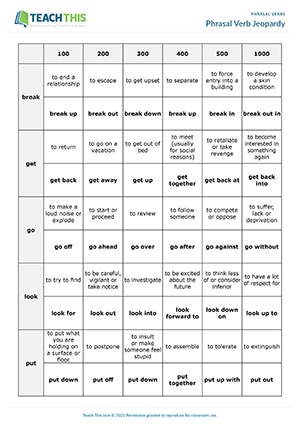

The terminology of phrasal verbs is inconsistent. Thus the distinction between particles and prepositions is made by function, because the same word can function sometimes as a particle and sometimes as a preposition. – The object of the particle verb can precede the particle – The object of the preposition cannot precede the preposition in the phrasal verb. – The object of the particle verb can precede the particle. – The object of the preposition cannot precede the preposition. In contrast, the object of a preposition can never precede the preposition. When the object of a particle verb is a definite pronoun, it can and usually does precede the particle. A simple diagnostic distinguishes between the, however. This similarity is source of confusion, since it obscures the difference between prepositional and particle verbs. When a particle verb is transitive, it can look just like a prepositional verb. The aspect of these types of verbs that unifies them under the single banner phrasal verb is the fact that their meaning cannot be understood based upon the meaning of their parts taken in isolation: the meaning of pick up is distinct from pick the meaning of hang out is not obviously related to hang.ĭistinguishing phrasal verb types – in is a particle and for is a preposition. – up is a particle and on is a preposition f. – off is a particle and on is a preposition. – down is a particle and on is a preposition. The other tanks were bearing down on my Panther. – forward is a particle and to is a preposition. Who can put up with that? – up is a particle and with is a preposition. Just as for prepositional verbs, particle-prepositional verbs are not separable. Verb + particle + preposition (particle-prepositional verbs) Many phrasal verbs combine a particle and a preposition. Where do they want to hang out? – out is a particle, not a preposition. Why does he always dress down? – down is a particle, not a preposition. If they are transitive, they are separable. These verbs can be transitive or intransitive. – by is a preposition that introduces the prepositional phrase by your friend Verb + particle (particle verbs) When the element is a particle, it cannot (or no longer) be construed as a preposition, but rather is a particle because it does not take a complement. – for is a preposition that introduces the prepositional phrase for a linguist. – after is a preposition that introduces the prepositional phrase after her mother.

– into is a preposition that introduces the prepositional phrase into an old friend. – on is a preposition that introduces the prepositional phrase on nobody. Who is looking after the kids? – after is a preposition that introduces the prepositional phrase after the kids. These phrasal verbs can also be thought of as transitive and non-separable the complement follows the phrasal verb.
#List of phrasal verbs for esl full
Verb + preposition (prepositional verbs) When the element is a preposition, it is the head of a full prepositional phrase and the phrasal verb is thus prepositional. The phrasal verb constructions in the following examples are in bold. There are at least three main types of phrasal verb constructions depending on whether the verb combines with a preposition, a particle, or both.
#List of phrasal verbs for esl free
Phrasal verbs are differentiated from other classifications of multi-word verbs and free combinations by criteria based on idiomaticity, replacement by a single-word verb, wh-question formation and particle movement. Additional alternative terms for phrasal verb are compound verb, verb-adverb combination, verb-particle construction, two-part word/verb or three-part word/verb (depending on the number of particles) and multi-word verb. Phrasal verbs that include a preposition are known as prepositional verbs and phrasal verbs that include a particle are also known as particle verbs. In other words, the meaning is non- compositional and thus unpredictable. These semantic units cannot be understood based upon the meanings of the individual parts alone, but must be taken as a whole. There are tens of thousands of them, and they are in everyday, constant use. These exercises will help you use phrasal verbs correctly.In English traditional grammar, a phrasal verb is the combination of two or three words from different grammatical categories – a verb and a particle, such as an adverb or a preposition – to form a single semantic unit on a lexical or syntactic level. Most native speakers use these all time, so the more you use them, the more "natural" you will sound. Learning and using phrasal verbs is an extremely important part of mastering English.


 0 kommentar(er)
0 kommentar(er)
